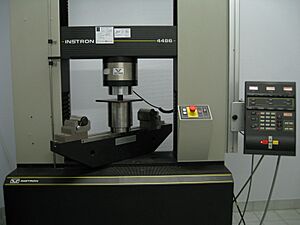Compression (physics) facts for kids
In the world of physics and engineering, compression is what happens when you push on something from different sides, trying to make it smaller. Imagine squeezing a sponge or pushing down on a spring. These are examples of compression.
It's the opposite of tension, where you pull something apart. Compression forces push inwards, while tension forces pull outwards. Understanding how materials handle compression is super important for engineers when they design buildings, bridges, and many other things.
Sometimes, forces push in just one direction. This is called uniaxial compression. Think about standing on a soda can – you're applying uniaxial compression to it. Forces can also push in multiple directions, like when you squeeze a balloon from all sides. This is called isotropic compression. Liquids and gases can only handle this type of compression.
Contents
What Happens When Things Are Compressed?
When you compress something, it changes shape. This change is called deformation. Even if you can't see it, the tiny atoms and molecules inside the material move closer together.
- Temporary Change: If the compression forces are removed, the material might go back to its original shape. Think of a spring bouncing back after you push it down.
- Permanent Change: If the forces are too strong, the material might stay squished or even break. Imagine crushing that soda can – it won't go back to its original shape.
Liquids and gases are different from solids. You can't really compress a liquid or gas in just one direction and expect it to hold its shape. They will just spread out or flow. But you can compress them from all sides, like the air in a bicycle tire.

Most everyday materials will get smaller in volume when compressed from all sides. If you push on a material from two sides (like squeezing a block), it will usually get shorter in that direction and wider in the other directions. How much a material changes shape under compression is a big part of continuum mechanics, which is a branch of physics.
How We Use Compression
Compression is used in many ways in science and engineering.
Testing Materials
Engineers use special machines to compress materials until they break. This helps them find out how strong a material is and how much it can bend or stretch before it changes permanently. These tests are important for choosing the right materials for buildings, cars, and other structures. Some machines are small enough for a tabletop, while others are huge and can apply massive forces.
Storing and Moving Things
Gases like oxygen or natural gas are often stored and shipped in highly compressed tanks. This saves a lot of space because the gas takes up much less room when it's squeezed. Think of a scuba tank or a propane cylinder for a grill.
Slightly compressed air is also used to fill things like balloons, rubber boats, and inflatable toys. Compressed liquids are used in hydraulic equipment, like the brakes in a car or the powerful arms of construction machines.
Compression in Engines
Car Engines
In internal combustion engines (like those in cars), a mixture of fuel and air is pulled into the engine's cylinders. Then, a piston moves up and compresses this mixture. Squeezing the mixture makes it much more powerful when it's ignited, which helps the engine run more efficiently and produce more power. This is a key step in how most car engines work.
Steam Engines
Older steam engines also used compression. Before the piston finished its movement, a valve would close, trapping some of the exhaust steam in the cylinder. This trapped steam would get compressed, creating a "cushion" that helped slow down the piston smoothly. This made the engine run more quietly and put less stress on its parts. It also helped prepare the cylinder for the next burst of fresh steam.
See also
 In Spanish: Compresión (física) para niños
In Spanish: Compresión (física) para niños
- Buckling
- Compressive strength
- Longitudinal wave
- Rarefaction
- Strength of materials



